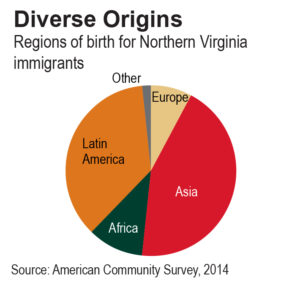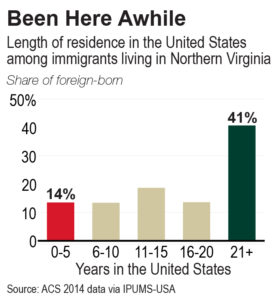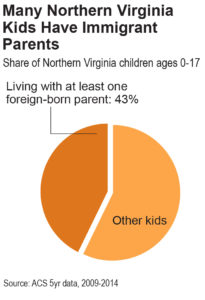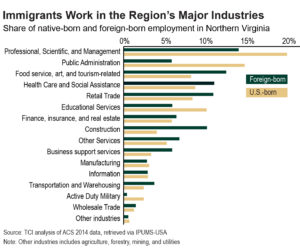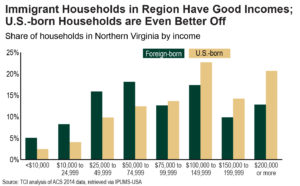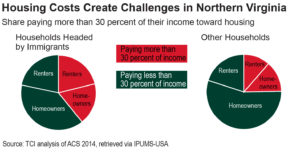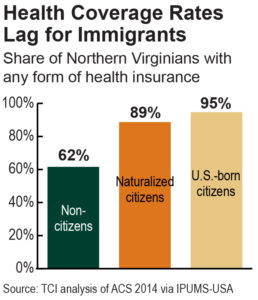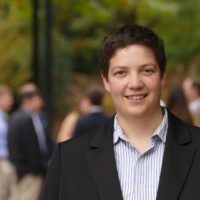June 10, 2016
Vital for Prosperity — Northern Virginia
The facts about immigrants and their contributions to the Northern Virginia economy
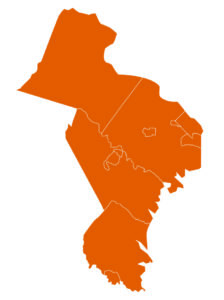
Northern Virginia’s 671,000 immigrants are a critical component of the region’s economic strength and an integral part of family life and communities. Foreign-born Virginians make up 26 percent of the region’s residents, twice the rate as in Virginia or the United States as a whole. The region’s immigrants are generally very well-educated, have high levels of employment, and are well-paid, although their incomes often lag those of their U.S. born neighbors in Northern Virginia.
Contrary to some common misconceptions about immigrants, Northern Virginia’s foreign-born residents are from a wide variety of places. Eight in 10 were born in Asia or Latin America, and there are immigrants in the region from Europe, Africa, and Canada. El Salvador is the most common country of birth among area immigrants, accounting for 12 percent of all foreign-born residents, followed by India and Korea.
Fairfax County is home to more than half of all foreign-born residents of Northern Virginia (see map for this report’s definition of the region), compared to about four in 10 U.S.-born Northern Virginia residents.
Most foreign-born residents of the region have been in the United States for many years. About a third entered the country before 1990, and more than half have been in the U.S. for more than 15 years.
Half of foreign-born Northern Virginia residents are naturalized U.S. citizens, having completed a lengthy process that requires many years of legal residence and passing a test on U.S. history, laws, and customs, among other requirements. This rate is similar to that of all foreign-born Virginians.
Immigrants in Northern Virginia are primarily working age. As a result, there are relatively few foreign-born children in Northern Virginia compared to the large number of U.S.-born children. However, many working-age immigrant Virginians have children who are native-born Americans, indicating that most immigrants in the area have strong ties to the community. Within the region, 257,000 children have at least one foreign-born parent. That’s 43 percent of the region’s kids, which is almost twice the rate as in Virginia or the country as a whole.
With most immigrants in the region being working-age, it’s not surprising that most have jobs. Seven of every 10 foreign-born adult residents of Northern Virginia are working, a similar rate to that of U.S.-born residents of the region. This includes 47,000 self-employed workers, of whom 19,000 own their own incorporated businesses. That’s more than 40 percent of all incorporated business owners in the region. Immigrants in Northern Virginia are 50 percent more likely than U.S.-born residents of the region to be working at their own incorporated business. And immigrant residents, like their U.S.-born neighbors, work in a variety of fields, including all of the region’s biggest employment sectors. However, immigrant workers are underrepresented in public employment and in the highly-paid professional, scientific, and management sector.
Many foreign-born adult residents of Northern Virginia are very well educated. Almost half have at least a bachelor’s degree, and 21 percent have an advanced degree, far higher rates than are typical in the United States as a whole. However, U.S.-born residents of the region are even better educated, with almost two-thirds having at least a bachelor’s degree, twice the rate as in the country as a whole. And foreign-born residents of the region are much more likely than U.S. born adults in the area to lack a high school diploma or equivalent.
As might be expected, based on the high levels of education among many immigrants in the region and the large number who were born in India, where English is among the official languages, the majority of immigrants in Northern Virginia speak English. One in 7 foreign-born residents of Northern Virginia speaks only English and another 45 percent speak English “very well.” These rates contribute to the employment success of immigrants in the region. But it is important to also consider the needs of the 4 in 10 foreign-born residents of the region who do not speak English at least “very well.” Services like English language instruction and bilingual public information can help non-English-speaking adults build their skills and take a bigger role in the area’s economy and civic activities.
Driven in part by high employment and education levels, Northern Virginia has relatively high household incomes. However, incomes for immigrant-headed households in the region lag the very high incomes that are typical among the U.S.-born. Just over half of the region’s households headed by immigrants have incomes above $75,000 a year, compared to 71 percent of U.S.-born households in the region. By comparison, just 35 percent of all households in the rest of Virginia (excluding Northern Virginia) have incomes above $75,000 a year.
As with U.S.-born residents of the region, there are many immigrants in Northern Virginia who are struggling with insufficient wages and income to meet the high cost of living. Nearly one in 3 immigrant workers in the region makes less than $12 an hour; less than one in 5 U.S.-born workers in the region make such low wages. And about one in 10 foreign-born residents in Northern Virginia lives in a household whose income is under the poverty threshold, almost twice the rate for U.S.-born residents of the region. Some economic challenges in Northern Virginia can affect even higher-income immigrant families.
Housing costs are one of the major challenges for many households in the region, particularly immigrant families. A majority of immigrant-headed households in Northern Virginia are homeowners, and nearly a third of those immigrant homeowners are paying more than 30 percent of their income on housing costs, which is more than is considered affordable by the Department of Housing and Urban Development. That’s compared to 19 percent of U.S. born homeowners in the region who are paying a high share of their income toward housing costs.
Forty-three percent of immigrant-headed households in the region are renters, compared to 32 percent of other households. Renter households in Northern Virginia, whether headed by immigrants or not, are more likely than homeowners to be paying high shares of their income toward housing costs, and immigrant-headed renter households are even more likely than the U.S. born to be cost burdened. Half of immigrant-headed renter households pay more than 30 percent of their income toward housing, compared to 37 percent of households headed by a U.S.-born person.
And although foreign-born residents of Northern Virginia fare well on most measures of economic well-being and stability, they are far less likely than U.S.-born residents to have health insurance. While 95 percent of U.S.-born residents of the region have health insurance, only 75 percent of foreign-born residents have coverage. The problem is particularly acute for non-citizen immigrants, who have very limited access to public coverage. But even naturalized U.S. citizens have lower coverage rates than the U.S. born. The differences in public coverage for citizens compared to non-citizens are particularly stark: 18 percent of both U.S.-born and naturalized residents of Northern Virginia have public health insurance coverage, compared to 9 percent of non-citizens in the region. More than a third of non-citizens—128,000 area residents—have no coverage. Although some of this data was gathered before the major coverage expansions of the Affordable Care Act, non-citizens are ineligible for many of those expansions. As a result, many of them are likely to remain uninsured.
Addressing challenges such as too low wages, housing affordability, and health coverage that particularly affect immigrants in Northern Virginia can help make sure all of Virginia’s immigrant workers are able to focus on putting their education and skills to work improving the future of their families and our communities. And it can help ensure all of the region’s children—no matter where their parents were born—have the stability and security that is so important for them to achieve their highest potential. When we build a region that works for all of us, we all win.
